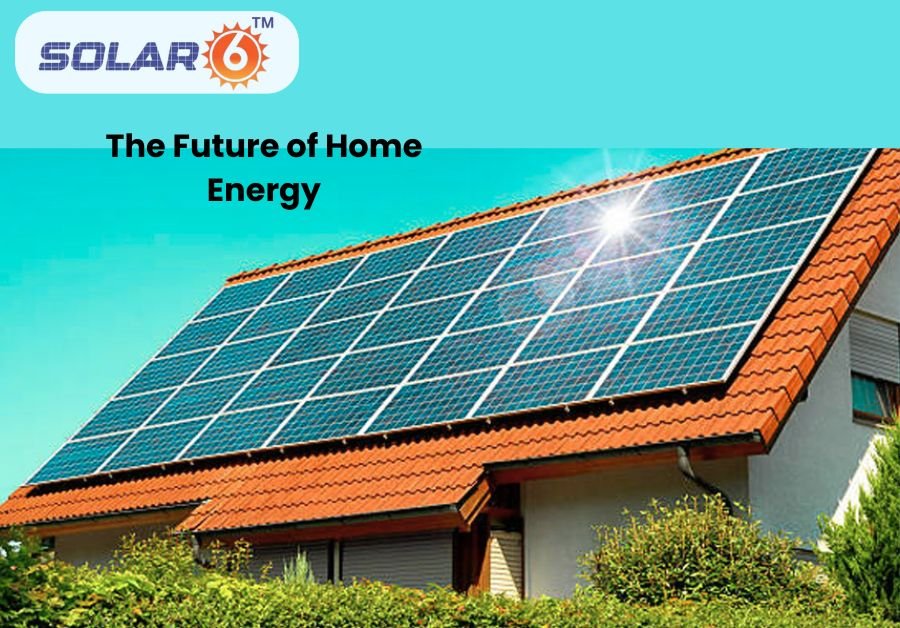The way we power our homes is evolving rapidly, and rooftop solar panels are at the forefront of this energy revolution. With rising electricity costs, environmental concerns, and government incentives, solar energy for homes is no longer a luxury; it’s a necessity. Rooftop solar panels allow homeowners to generate their electricity, reduce dependence on the grid, and contribute to a cleaner planet.
In this article, Solar6 explores why rooftop solar is becoming the preferred energy solution for households across India, how it works, the benefits it offers, and practical installation tips.
1. Why Rooftop Solar Panels Are the Future
Rooftop solar panels harness sunlight and convert it into electricity, making them a sustainable solution for every home. Unlike traditional electricity, which relies heavily on fossil fuels, solar energy is clean, renewable, and abundant.
Governments across India are promoting rooftop solar through subsidies, tax incentives, and net metering policies. This makes it financially viable for homeowners to invest in solar panels and enjoy long-term savings. With technological advancements, modern solar panels are highly efficient, durable, and require minimal maintenance.
Investing in rooftop solar not only reduces electricity bills but also increases property value. As cities focus more on green energy solutions, homes equipped with solar panels are considered more sustainable and energy-independent.
2. Benefits of Installing Rooftop Solar Panels
a) Cost Savings on Electricity Bills
One of the most immediate advantages of rooftop solar is the reduction in monthly electricity expenses. By generating your own electricity, households can save thousands of rupees annually.
b) Environmental Impact
Solar energy is clean and reduces the carbon footprint. Every kilowatt-hour (kWh) of solar power generated reduces reliance on fossil fuels and prevents harmful emissions.
c) Energy Independence
Rooftop solar allows homeowners to be less dependent on grid electricity, protecting them from power cuts and fluctuating rates.
d) Government Incentives and Subsidies
The Indian government offers subsidies for rooftop solar installation, making it easier for households to adopt solar energy. Net metering allows users to sell excess power back to the grid.
e) Low Maintenance and Durability
Modern solar panels are designed to last over 25 years with minimal maintenance. Cleaning a few times a year and periodic inspections ensure optimal performance.
3. How Rooftop Solar Panels Work
Rooftop solar panels consist of photovoltaic (PV) cells that convert sunlight into direct current (DC) electricity. An inverter then transforms DC into alternating current (AC), which powers your home appliances.
The solar system can be designed based on your home’s energy requirements. For example:
- Grid-tied systems: Connect to the local electricity grid; excess power can be fed back via net metering.
- Off-grid systems: Store power in batteries for use when sunlight isn’t available.
- Hybrid systems: Combine grid-tied and battery backup for uninterrupted power.
Proper placement and orientation of panels are crucial for maximum efficiency. A professional solar installer will evaluate roof size, sunlight exposure, and energy needs to design an optimal system.
4. Rooftop Solar Panels for Every Home
Rooftop solar is no longer limited to large homes or businesses. With flexible designs and affordable options, every household can harness solar energy.
Apartments and high-rises: Community solar solutions or shared rooftop installations.
Independent homes: Standard grid-tied systems with battery backup.
Rural homes: Off-grid solar systems for areas with limited electricity access.
The affordability of solar panels has improved dramatically in recent years, and government subsidies can cover up to 40% of installation costs for residential users. Companies like Solar6 are providing reliable and cost-effective solar solutions tailored to Indian households.
5. Choosing the Right Solar Installer
Selecting a trusted solar installer ensures a smooth installation process and long-term performance. Look for:
- Verified experience and certifications
- Transparent pricing and financing options
- Quality solar panels with manufacturer warranties
- Post-installation support and maintenance
Professional installers will handle permits, net metering applications, and optimal system design. Choosing a reputable provider like Solar6 ensures high-quality panels, reliable installation, and continued support.
6. Tips for Maximizing Solar Efficiency
- Ensure panels receive at least 5–6 hours of direct sunlight daily.
- Keep panels clean and free from debris.
- Regularly inspect wiring, inverters, and battery backups.
- Monitor energy consumption and adjust appliances for peak solar usage.
- Consider hybrid systems for energy storage during cloudy days.
By following these simple tips, homeowners can maximize energy generation, reduce bills, and enjoy uninterrupted solar power.
7. Future Trends in Rooftop Solar
The future of rooftop solar looks promising with innovations such as:
- Smart solar systems: Integration with home automation and AI for energy management.
- Building-integrated photovoltaics (BIPV): Solar panels embedded into roofs, windows, or facades.
- Advanced energy storage: Longer-lasting batteries with higher efficiency.
- Community solar projects: Shared solar farms powering multiple homes.
As technology evolves, rooftop solar will become more affordable, efficient, and accessible for every household.
Conclusion
Rooftop solar panels are no longer a futuristic concept; they are the future of home energy. By adopting solar energy, homeowners can enjoy cost savings, environmental benefits, and energy independence. With government incentives, affordable solutions, and professional installation services like Solar6, every home can embrace clean, sustainable energy.
Making the switch to rooftop solar is not just an investment in your home, but it’s an investment in a greener, smarter, and more sustainable future.

